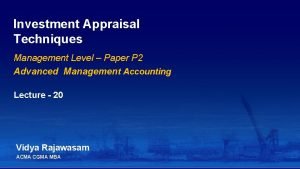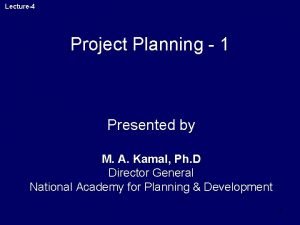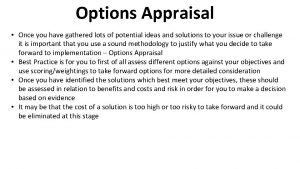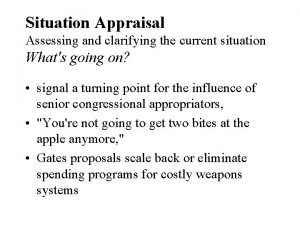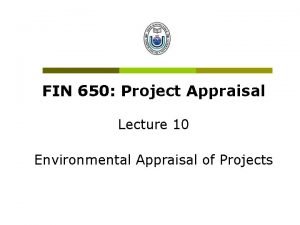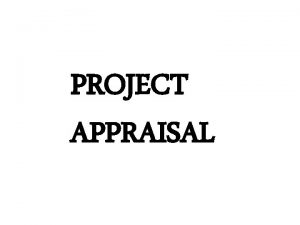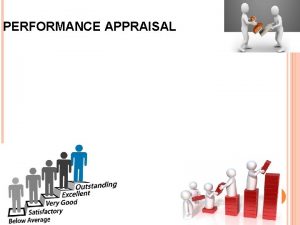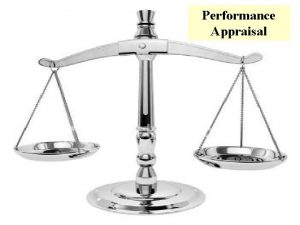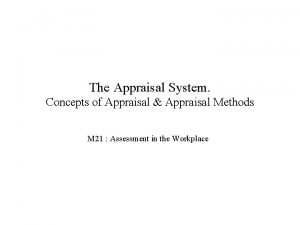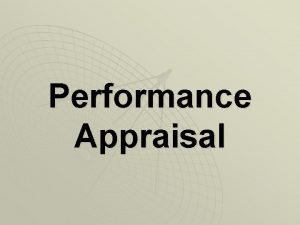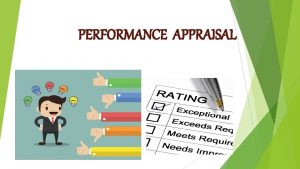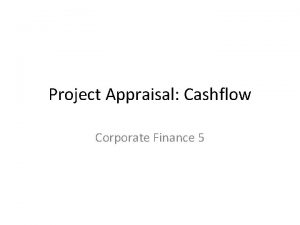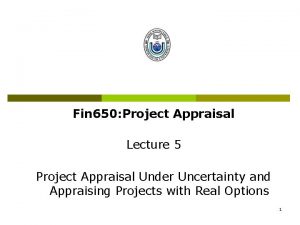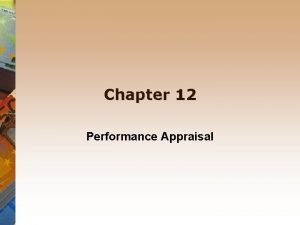PROJECT APPRAISAL PROJECT APPRAISAL MEANING It is a














- Slides: 14

PROJECT APPRAISAL

PROJECT APPRAISAL: - MEANING • It is a process of detailed examination of several aspects of a given project. It is basically aimed at determining the viability of a project. • Such appraisal is usually done at two stages: Project identification stage, which is done by the firm. Project financing stage which is done by the financial institutions and banks make a critical appraisal of projects. • Project appraisal aims at increasing quality of projects, enhancing long-term profitability and minimizing risk.

Objectives of Project Appraisal • Project Appraisal is necessitated because the resources or means are limited as compared to the needs of the society. As a result, any investment undertaken implies depriving other projects resources. Hence, it is very important to appraise each project before investment decision so that scarce resources are utilized in the best possible ways. • In other words, before allocation of resources for a particular project, the decision making authority must convince itself that the proposed project is the best and most economical way of achieving the desired objective (in terms of socio-economic benefits).

Objectives of Project Appraisal • To ensure that scarce resources are put to most effective use. It requires the combined efforts of a team of persons from various disciplines such as engineers, financial analysts , economists, etc. working in close coordination. • Comparison of cost and benefits • Minute checking of projects • Measuring investment worth • Teamwork

Types of Project Appraisal • • • Economic Analysis Financial Analysis Market Analysis Technical Analysis Managerial Analysis

Methods/Techniques of Project Appraisal • • • PAY BACK PERIOD METHOD INTERNAL RATE OF RETURN NET PRESENT VALUE METHOD ACCOUNTING RATE OF RETURN PROFITABILITY INDEX

PAYBACK PERIOD • Payback technique states how long does it take for the project to generate sufficient cash-flow to cover the initial cost of the project. • XYZ Inc. is considering buying a machine costing Rs 100, 000. There are two options Machine A and Machine B. Machine A will generate revenue of Rs 50, 000, Rs 50, 000 & Rs 20, 000 in year 1, year 2 & year 3 respectively. Machine B will generate revenue of Rs 30, 000, Rs 40, 000 & Rs 60, 000 in year 1, year 2 & year 3 respectively. • As per above example payback period is 2 years & 2. 5 years for machine A & machine B respectively. According to the payback period method, machine A will be given preference. • The advantage of payback is, it is very easy to calculate & understand. Even people not from finance background can easily understand it. But the disadvantage is that it ignores the time value of money & anything that happens after a payback point.

ACCOUNTING RATE OF RETURN METHOD • Accounting rate of return is an accounting technique to measure profit expected from an investment. It expresses the net accounting profit arising from the investment as a percentage of that capital investment. It is also known as return on investment or return on capital. • The formula of ARR is as follows: ARR=(Average annual profit after tax / Initial investment) X 100

• • For Example, XYZ Inc. is looking to invest in some machinery to replace its current malfunctioning one. The new machine, which costs Rs 420, 000, would increase annual revenue by Rs 200, 000 and annual expense by Rs 50, 000. The machine is estimated to have a useful life of 12 years. Depreciation expense per year = Rs 420, 000/ 12 = Rs 35, 000 Increase in average annual profit = Rs 200, 000 – ( Rs 50, 000 + Rs 35, 000) = Rs 115, 000 Initial investment = Rs 420, 000 ARR = ( Rs 115, 000 / Rs 420, 000 ) * 100 = 27. 38%

NET PRESENT VALUE METHOD • Net present value is the sum of discounted future cash inflow & outflow related to the project. Generally, the weighted average cost of capital (WACC) is the discounting factor future cash-flows in net present value method. • In essence, this method sums up the discounted net cash flows from the investment by the minimum required rate of return & deducts initial investment to give the ‘net present value’. The company should accept the project if the NPV is positive.

• The formula of NPV ={ + + ……. . } – Initial Investment Where, CFi = Cash-flow of first period CFii = Cash-flow of second period CFiii = Cash-flow of third period CFn = Cash-flow of nth period n = No. of Periods i = Discounting rate

• For Example, • XYZ Inc. is starting the project at cost of Rs 100, 000. The project will generate cash-flow of Rs 40, 000 , Rs 50, 000 & Rs 50, 000 in year 1, year 2 & year 3 respectively. Company’s WACC is 10%. Find out NPV. • Formula of NPV = [ Rs 40, 000/( 1+0. 1)1] + [ Rs 50, 000 / (1+0. 1)2 ] +[ Rs 50, 000/ (1+0. 1)3 ] – 100, 000 Net present value = Rs 36, 363. 63 + Rs 41, 322. 31 +Rs 37, 565. 74 – Rs 100, 000 = Rs 115, 251. 68 – Rs 100, 000 • The net present value of the project is Rs 15, 251. 68. • Here, the net present value of the project is positive & therefore the project should be accepted.

INTERNAL RATE OF RETURN METHOD • An internal rate of return is the discounting rate, which brings discounted future cash flow at par with the initial investment. In other words, it is the discounting rate at which the company will neither make loss nor make a profit. • It is obtained by trial & error method. We can also state that IRR is the rate at which the NPV of the project will be zero. i. e. Present value of cash inflow – Present value of cash outflow = zero

PROFITABILITY INDEX • Profitability index defines how much you will earn per dollar of investment. The present value of an anticipated future cash flow divided by initial outflow gives the profitability index (PI) of the project. It is also one of the easy investment appraisal technique. • Suppose, the present value of anticipated future cash flow is Rs 120, 000 & Initial outflow is Rs 100, 000. Then the profitability index is 1. 2. i. e. Rs 120, 000 / Rs 100, 000. Which means each invested dollar is generating revenue of 1. 2 dollars. If the profitability index is more than 1, the project should be accepted & if it is less than 1 it should be rejected.
 Project appraisal
Project appraisal Tii project appraisal guidelines
Tii project appraisal guidelines Project appraisal and management
Project appraisal and management Advantages of project appraisal
Advantages of project appraisal Explain the concept of project appraisal
Explain the concept of project appraisal Pra in community organization
Pra in community organization Options appraisal template
Options appraisal template Display rules psychology
Display rules psychology Health appraisal meaning
Health appraisal meaning Situation appraisal
Situation appraisal Environmental appraisal meaning
Environmental appraisal meaning Reflected appraisal
Reflected appraisal Traditional method of performance appraisal
Traditional method of performance appraisal Turas dashboard
Turas dashboard Swot analysis of performance management system
Swot analysis of performance management system



